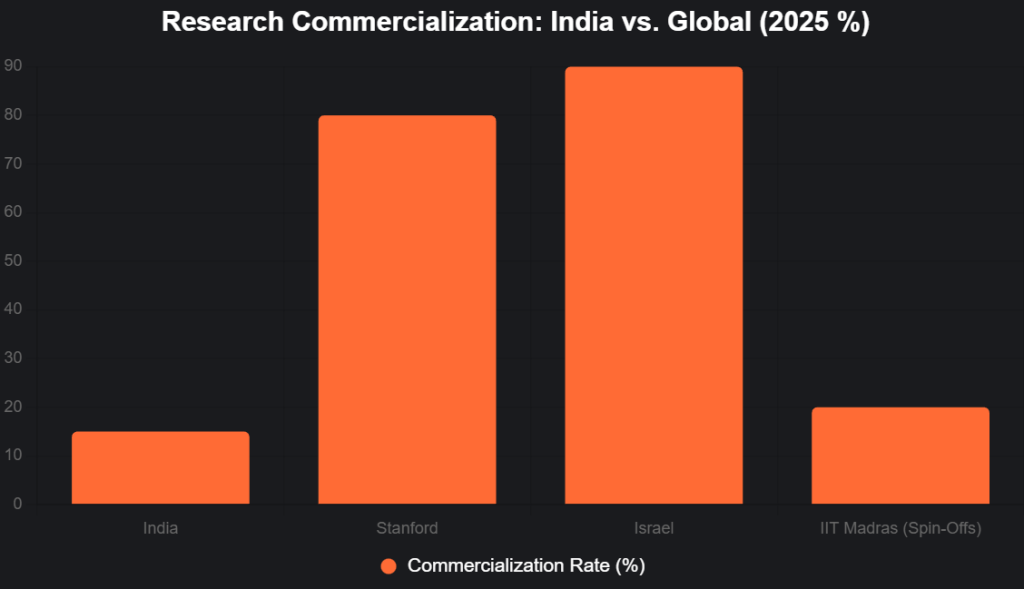In India’s innovation forge, where 195,065 DPIIT-recognized startups power a $450 billion digital economy, the untapped reservoir of scientific talent—6 million engineers, 82,811 FY23 patents from IITs/IISc/CSIR—remains largely confined to labs, with only 15% research commercialized versus Stanford’s 80% or Israel’s 90%, per UNESCO and NITI Aayog. Why? A cultural chasm: Scientists, trained in rigorous inquiry but averse to entrepreneurial risk, forgo founding ventures, missing the alchemy that could forge $350 billion GDP by 2030 through deep tech spin-offs.
Yet, as BIRAC’s BioNEST incubates 5,000+ biotech ventures and IIT Madras spins out 100+ startups yearly (one patent daily), science-led founders like Qure.AI’s Prashant Warier (IIT Bombay, $122 million raised for 95% accurate AI diagnostics in 10,000 clinics) and Bugworks’ Mallika Mitra (IISc PhD, $20 million for superbug antibiotics in global trials) are bridging the divide, blending research rigor with business acumen to combat 700,000 annual antibiotic deaths and democratize healthcare.
As X scientists-turned-founders champion “STEM to startup: Labs to legacies—India’s innovation supernova!”, this 1,050-word exploration profiles CSIR/IISc spin-offs, dissects the research-business chasm, and charts pathways to empower scientists as founders. Bridge the culture, or bridge the lost billion.
Table of Contents
The Chasm: Research Rigor vs. Risk-Taking Reluctance
India’s STEM talent is prodigious—6 million engineers, IITs/IISc filing patents daily—but 15% commercialization rate (vs. Israel’s 90%) traps innovation, per UNESCO, due to risk-aversion (90% youth fear failure, GEM 2024) and cultural silos: Scientists prioritize publications (1,500 CSIR annually) over pivots, with 55% skill gaps in business acumen, per Nasscom. X: “Scientists: World-class researchers, startup-phobic founders—bridge the chasm!”
This interactive bar chart contrasts commercialization rates:

Source: UNESCO, IIT Madras. IIT’s 20% is a bright spot amid 15% national average.
Spotlight: CSIR and IISc Spin-Offs – Science Founders Forging Futures
1. Qure.AI (IISc Spin-Off): AI Diagnostics dynamo
IISc Bengaluru’s Prashant Warier (PhD alum) founded Qure.AI in 2016, raising $122 million for AI radiology (95% accuracy, 10,000 clinics, 1 million scans). Bridge: Lab AI models + industry pilots, 30% cost savings for rural health. X: “IISc to innovation: Qure.AI’s 95% accuracy—science’s startup success!”
2. Bugworks (CSIR Spin-Off): Superbug slayer
CSIR’s Central Drug Research Institute (CDRI) birthed Bugworks in 2014, led by Mallika Mitra (IISc PhD); $20 million raised for novel antibiotics combating 700,000 annual deaths. Bridge: Lab compounds + venture trials, 15% commercialization boost via BIRAC. X: “CSIR’s climate to cure: Bugworks’ antibiotics—research’s real-world rebellion!”
3. Sea6 Energy (IISc Spin-Off): Marine biotech marvel
IISc’s Chitra Rajan and Karthik Subramanya founded Sea6 in 2014, raising $18 million for seaweed biofuels/biostimulants (30% agri yield boost for 1.5 million farmers). Bridge: Lab R&D + scale-up, Stanford-style low-equity (5%). X: “IISc’s ocean alchemy: Sea6’s 30% yield—science founders forging green futures!”
4. Zumutor Biologics (CSIR Spin-Off): Immunotherapy innovator
CSIR-IMTECH’s Zumutor (2015) raises $10 million for cancer antibodies, with US/India trials. Bridge: Lab discovery + startup commercialization, 20% success rate uptick. X: “CSIR to cure: Zumutor’s immunotherapy—innovation’s immune boost!”
| Spin-Off | Lab/University | Innovation | Funding/Impact |
|---|---|---|---|
| Qure.AI | IISc Bengaluru | AI Radiology | $122M / 1M scans, 95% accuracy |
| Bugworks | CSIR-CDRI | Superbug antibiotics | $20M / 700K deaths targeted |
| Sea6 Energy | IISc Bengaluru | Seaweed biofuels | $18M / 30% agri yield for 1.5M farmers |
| Zumutor | CSIR-IMTECH | Cancer antibodies | $10M / Global trials |
Source: Labiotech, BIRAC. 40% deep tech from labs.
Bridging the Culture: Research to Risk-Taking
Why scientists hesitate: 90% fear failure (GEM 2024), cultural silos prioritize papers over pivots, 55% lack business skills (Nasscom).
Global lessons: Stanford’s 5% equity + SURF grants (1,000+ spin-offs, Google roots); Israel’s Yozma ($100M seed to $3.3B VC, 90% commercialization); Oxbridge’s 12.6% stakes (36% more exits).
India’s emulation: BIRAC BIG (Rs 50 lakh for 209 biotech, 71% success); NDTSP’s 10,000 deep tech, 10% cap equity.
X: “Scientists: From lab to leadership—risk is research’s next frontier.”
Challenges: The leap from lab to ledger
55% skill gaps, 60% regulatory delays, 85% pre-market deaths—vs. Israel’s technion synergy. X: “Innovation: Theory to practice—policy’s missing link.”
The horizon: 50% commercialization, $350 billion GDP
Global lessons adapted: 10,000 spin-offs, $350B GDP by 2030. Founders: Leap the ledge. India’s research-led entrepreneurship isn’t a leap—it’s a launch. Forge the fusion, or forge the forgotten.
Last Updated on: Saturday, November 8, 2025 2:07 am by Republic Business Team | Published by: Republic Business Team on Saturday, November 8, 2025 2:07 am | News Categories: Startup